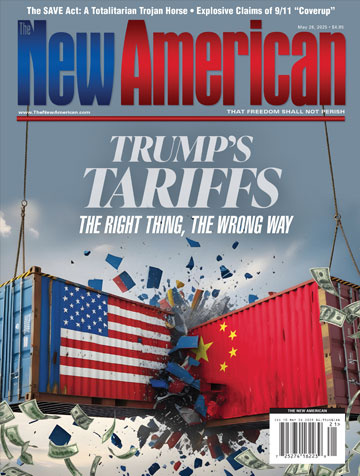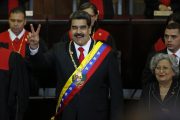
Argentina plans to pay for most of its monthly imports from China in yuan rather than in U.S. dollars, Economy Minister Sergio Massa announced on April 26.
Buenos Aires and Beijing inked a currency-swap agreement last year to curtail the outflow of foreign currency from Argentina’s central bank.
China is presently Argentina’s second-largest trade partner after Brazil, and the second-largest destination for Argentinian exports. In 2021, Argentina’s total imports from China amounted to around $13.5 billion, based on the UN database on international trade.
Massa declared that Buenos Aires will pay the equivalent of $1 billion in yuan for Chinese goods and services this month, with $790 million of monthly imports paid for in yuan each month thereafter.
Moreover, this currency-swap agreement, broadened and finalized earlier this year, permits Argentinian exporters to transact yuan or dollars to balance the flows of foreign currencies in the central bank.
Last year, the dollar’s share in global reserves dropped 10 times faster than over the past 20 years, Stephen Jen, the CEO of London-based asset-management company Eurizon, told Bloomberg. After other countries witnessed Russia’s dollar- and euro-denominated assets frozen abroad and Moscow excluded from the SWIFT global financial messaging system, the drive to reduce dependence from the greenback only increased.
Also, U.S. Secretary of the Treasury Janet Yellen recently acknowledged that the role of the dollar as the world reserve currency could drop as Washington has been leveraging its dominance over the international financial system to impose its geopolitical goals via sanctions.
Following a trying period of drought that has evaporated around $20 billion in agricultural exports from its economy compared to 2022, amounting to about $7.4 billion in lost government revenue as indicated by the Rosario Board of Trade, Argentina’s economic situation has not been rosy. Furthermore, an article in Forbes stated that as the country’s Central Bank led by Miguel Ángel Pesce had to sell $3 billion in the first quarter of this year to control the peso-dollar exchange rate, worries over a potential default have increased together with a depletion of the Central Bank’s reserves.
On April 27, Argentina’s central bank increased its benchmark interest rate a huge 10 percentage points to 91 percent to curb high inflation and stabilize the peso, which has seen a nosedive in black market trading over the last week.
The hike, the largest since a market meltdown in August 2019, came after the central bank (BCRA) had already lifted the rate last week by 300 basis points to 81 percent in an effort to control inflation levels at 104 percent yearly, as well as prices that have been predicted to rise this year by some 110 percent to 130 percent.
A higher interest rate would provide more incentives to savers to keep their funds in pesos, strengthening the local currency, but would serve as a deterrent to borrowing.
The bank proclaimed it had increased the benchmark rate to shift toward “real returns on investments in local currency” and to encourage savings in pesos. The 91-percent rate would cover fixed-term 30-day deposits of up to 30 million pesos.
“The BCRA will continue to monitor the evolution of prices, the dynamics of the financial and forex markets, and monetary aggregates in order to calibrate its rates policy,” it said.
Analysts warned that such a measure was only a Band-Aid for Argentina’s many economic problems.
“The rate increase is a promising measure, but late,” said Sergio Chouza from the Sarandí consultancy.
Analyst Leonardo Chialva added that the move would not fix the root issues, amid mounting pressure on Argentina’s government to spend prior to general elections in October.
“The underlying problem is the fiscal one, and the cure needed is difficult to pull off in an election year,” Chialva said.
Notably, Argentina has a $44 billion loan program with the International Monetary Fund (IMF), which encompasses goals to have a positive real interest rate, control inflation, and accumulate foreign currency reserves.
Likewise, earlier this year, neighboring Brazil secured an agreement with China to conduct bilateral trade in their own respective currencies, excluding the U.S. dollar as an intermediary.
On a recent visit to China, Brazilian leader Luiz Inácio “Lula” da Silva urged developing nations to pivot away from the U.S. dollar and toward their own currencies. Additionally, India is also planning to use the rupee or the yuan for trade with China, while Russia began to accept payments for its exports in rubles and yuan.
Concurrently, China also conducted its first-ever trade of liquified natural gas settled completely in yuan with France’s TotalEnergies.
The Sino-Brazil decision to conduct non-dollar trade is a landmark move and has been perceived by many as a clear indication that countries are seeking to rely less on the greenback.
A Reuters report on April 26 stated that the yuan surpassed the U.S. dollar to become the most-used currency in China’s cross-border transactions last month, quoting official data.
Cross-border payments and receipts in yuan soared from $434.5 billion in February to a historic $549.9 billion in March, according to data from the State Administration of Foreign Exchange.
48.4 percent of all China’s cross-border transactions used the yuan, showcasing Beijing’s efforts to promote the use of the yuan. In contrast, the proportion of the dollar in China’s international settlements decreased from 48.6 percent in February to 46.7 percent last month.
Since the end of the Second World War, the U.S. dollar has been the global reserve currency and a benchmark for international trade after the United States and its allies set up the Bretton Woods system of monetary management in 1944.
For decades, global commodities, particularly oil, have been priced according to the U.S. dollar. As banks have conducted transactions in terms of U.S. dollars, the dollar has become essential to the global economy.
That being said, while the dollar would likely remain a key element in global trade and economics, at least in the near future, given the trend towards de-dollarization and use of alternative currencies such as the yuan for cross-border payments, America will be able to rely less on it to pursue its geopolitical goals while imposing sanctions on dissenting states.




